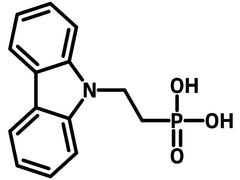2PACz
CAS Number 20999-38-6
Charge Transport Layer Materials, Materials, OLED Materials, Perovskite Interface Materials, Perovskite Materials, Self-Assembled Monolayers (SAMs),Self-Assembled Monolayer with Carbazole-based Phosphonic Acid
Hole transport or extraction layer for highly efficient NFA-polymer solar cells and p-i-n perovskite solar cells, CAS No. 20999-38-6
2PACz ((2-(9H-carbazol-9-yl)ethyl)phosphonic acid) is a bench-mark self-assembled monolayer (SAM) material that consists of an electron rich carbazole body with an ethyl phosphonic acid anchoring group as hole selective layer (HSL) interface for inverted perovskite solar cells.
This material acts as HSL by self-assembling on the surface of indium-tin-oxide (ITO) substrates in organic solar cells and perovskite solar cells. It can also replace PEDOT:PSS as hole transport or extracting layer material. As an interface layer, 2PACz changes the work function of ITO while altering the morphology of active layer materials.
In perovskite solar cells, 2PACz exhibits a well-suited energetic alignment and significantly reduces non-radiative recombination at the contact/perovskite interface, outperforming those based on benchmark hole transport layer materials. This self-assembled monolayer has a better band alignment to the valence band of the perovskite absorber, compared to commonly used HTL PTAA.
The use of 2PACz has enabled almost lossless contacts, minimum interfacial recombination, and improved power conversion efficiency in single-junction and tandem solar cells. 2PACz causes spontaneous vertical phase separation of photoreactive layers, forming a vertical component distribution to improve carrier yield-mobility, and suppress the trap-assisted recombination and leaking current in indoor OPVs.
World-record high efficiency of 20.17% (19.79% certified, published on 21 March 2024) was achieved for organic polymer non-fullerene solar cells based on a ternary active layer of PM6:L8-BO:eC9 by engaging 2PACz as the self-assembled interlayer (SAI) to form a a thin layer of 2–6 nm, enabling a full coverage on the substrate (not a monolayer but few layers coverage) [1].
Serving as hole selective contact for organic solar cells and perovskite solar cells, 2PACz is an alternative to PEDOT:PSS with superior performance with the convenience of solution deposition at low concentration, i.e. 1 mM.
Solution Processing Procedure
Typical processing solvents: ethanol, methanol, THF, IPA, DMF
Typical concentration: 1 mM (0.275 mg/ml) or 1.0 mg/ml (1 mg 2PACz is dissolved in 1 ml ethanol)
Typical processing procedure: 100 uL of 2PACz solution is deposited onto the centre of the substrate surface and spin-coated for 30 s at the speed of 3000 rpm. The coated substrate is then cooled to room temperature after being annealed annealing for 10 min at 100 ℃.
General Information
| CAS Number | 20999-38-6 |
|---|---|
| Chemical Formula | C14H14NO3P |
| Molecular Weight | 275.24 g/mol |
| Absorption* | λmax 340 nm (on ITO glass) |
| Fluorescence | λem (n.a.) |
| HOMO/LUMO | HOMO = 5.6 eV, LUMO = 2.1 eV [2] |
| Synonyms | (2-(9H-carbazol-9-yl)ethyl)phosphonic acid |
| Classification or Family | Carbazole derivatives, Self-assembly monolayers, Hole transport layer, Hole extraction layer, p-i-n Perovskite solar cells, Organic photovoltaics |
Product Details
| Purity | > 98% (1H NMR) |
|---|---|
| Melting Point | Tm = 231 ° C |
| Appearance | Off-white powder/crystals |
Chemical Structure

MSDS Documentation
Literature and Reviews
- Self-Assembled Interlayer Enables High-Performance Organic Photovoltaics with Power Conversion Efficiency Exceeding 20%, S. Guan et al., Adv. Mater., 2400342 (2024); DOI: 10.1002/adma.202400342.
- Advantages and challenges of self-assembled monolayer as a hole-selective contact for perovskite solar cells, S. Wang et al., Mater. Futures. 2, 012105 (2023); DOI: 10.1088/2752-5724/acbb5a.
-
Self-Assembled Monolayer Enables Hole Transport Layer-Free Organic Solar Cells with 18% Efficiency and Improved Operational Stability, Y. Lin et al., ACS Energy Lett. , 5 (9), 2935–2944 (2020); DOI: 10.1021/acsenergylett.0c01421.
Licensed by Helmholtz-Zentrum Berlin für Materialien und Energie GmbH in Germany and Kaunas University of Technology in Lithuania.

 2PACz MSDS Sheet
2PACz MSDS Sheet